Participants: Ron Amir, Ktzia Alon, Moran Shub, Ayoub 'Amar
Moderator: Eitan Bronstein Aparicio
25 people were in the audience.
Eitan:
I first saw Ron’s photographs in Sedeq, the magazine Zochrot published in 2007. They show families on the beach at Jisr a-Zarqa. My first response when I saw them was, What’s the trick? They seemed devious somehow. As if the families were posing for the camera, proudly displaying themselves to the world, to the photographer, to the viewers. Or maybe it’s the photographer who’s playing a trick, making fun of those kind of family photos? There was something very inviting about those photographs, intriguing and also surprising. Ron’s work, and this exhibit, raises interesting questions about photography and gaze, particularly in the Israeli/Palestinian context. What does photography offer the Israeli viewer? The Palestinian? But perhaps not necessarily to the Israeli/Palestinian. Someone asked, “Who is he?,” referring to Khaled Jarban, the man in the large photograph. Where was it taken? Some weren’t able to contextualize it because it’s somewhat confusing. Ron, please tell us about your work and how you selected the photographs for this exhibit.
Ron:
When Eitan suggested I exhibit my photographs at Zochrot, I decided I wasn’t interested in a conventional show of photographs, like in a museum. I’ve recently started looking at and thinking about smaller images, like the ones shown here, intended for the people they portray. Almost all these photos were taken at the request of their subjects, with a small digital camera that I keep in the car. A photo for appraisal purposes, for example, that someone asked me to take of the interior of an abandoned home to help him negotiate with the local council; a photograph after a birth; someone who wanted a photo of his fish store; a soccer team; photos of people with horses; a very small passport photo whose holder wanted another copy. Naturally, I know the subjects. They’re documents that the subjects will use for various purposes. I hung ninety of them, the size you get at an ordinary photo store but in which details are still visible. Regarding how they’re displayed – I wasn’t interested in any particular logical arrangement, neither an orderly grid nor a row of photos, so I began laying them out this way on the wall so they could be viewed as separate pictures. But there are also formal relationships among them as well as little jokes or an outlandish narrative – such as a photo of a horse jumping as if to catch candies thrown by a woman in the photograph above it, even though it’s obvious these are two separate events.
I wanted to place them opposite a single image, their antithesis. I always imagined it would be large, that I’d display it at some time. I took it with a 4 X 5 camera. I wanted to examine the relationships between these little photographs and the big one opposite them. About the photo itself - I stood a camera in his living room after we’d become acquainted. Someone suggested I meet Khaled Jarban, who’s known in the village as Jumbo, because his house is filled with objects. We took the photograph together. The session lasted a few hours. That’s what his living room looks like; Khaled sits there sewing fishing nets during part of the year. The photo’s title, “On Galilee’s Shore,” is ironic, drawn from the image by Reuven Rubin that appears in the photograph and extends its perspective to the rear. That image, of the painting “The Road to Tiberias,” is on a poster for an exhibit in the 1990’s called “On Galilee’s Shore.” The poster and other items were already there; I didn’t add them. The photo of Jamal, Khaled’s father, was also there, as well as other things. Essentially, this entire space allows me to investigate various aspects of photography.
Moran Shub, curator and photographic researcher:
What I have to say is somewhat esoteric - and perhaps very practical. I want to talk about portrait photography in general. I’ve never spoken about it, and found a common interest when I visited this exhibit. Consider how uncomfortable being photographed makes you. We don’t feel comfortable before the camera. To overcome that feeling, I suggest you hold something in your hands. Notice that everyone in these photographs who’s holding something in their hands has solved the problem, feels more secure. So you can understand why people walk along holding a cellphone; they feel they’re on a mission, they have a goal. It’s a form of grounding – they don’t have to deal with being afraid of the camera. Like an electrical ground which leads the current away, allowing the photographer to do what he wants. Funny things are happening in these photos: a guy holding a matzah. Ron, could you tell us how come he’s eating a matzah?
Ron:
There are matzahs during Passover; for Musa Jarban, one of the fishermen, it’s a nice, crispy snack. What interested me was the formal structures – the matzah’s shape against the background of the lines and the buildings behind him, the corrugated metal resembling the matzah.
Moran:
He’s presenting something absurd, a meeting of cultures, because Passover isn’t his holiday. We see the photo winking at us. A man in another photo is holding sugar sticks. Is that how he makes a living?
Ron:
During Ramadan, at night, after the family dinner, people sit eating sweets. There were years during which I set up a studio in the street and invited passers-by to have portraits taken. This is one of them.
Moran:
It’s clear to see its similarity to the photo with the matzah. You can see the dissonance. It’s not his occupation, it’s not what he usually eats, unlike the photos of fishermen holding fish. You can see how confidently they’re standing, how well they’re grounded. A mother holding her children is also confident of them; she’s not concerned that you’re taking pictures. Here’s what I’d like to propose: photography is one of the professions most likely to involve a mission. I recommend holding something in your hand, something intimate. Either connected to your job, or not. And in the context of this gathering at Zochrot, you might also say that the occupation involves holding something. Or you could simply be somewhere, love it, decide it belongs to you.
Ayoub Amar, a third-generation refugee from Tantura and cineaste:
Eitan, you said that Ron’s photos are inviting and interesting, but I feel there’s something repellent and alienating about them. I came home from the exhibit feeling uncomfortable, primarily because of the fact of the exhibit. Is such an exhibit appropriate? Do the photos chosen by the photographer speak to me? I’m from Fureidis, and I know Ron from Jisr. What does the general public know about Jisr and Fureidis? They know that Fureidis is a village that flooded during an unusually rainy winter decades ago, and where the intersection was blocked during the events of October, 2000. What do they know about Jisr? That someone once threw a rock at a passing car on the road – a threat. Or about the wall built to cut it off from Caesarea. Because it bothered the residents of Caesarea to see Jisr, so they built a wall to block the view. They’re also seen as thieves who must be watched. The general public, Palestinians as well as Jews, view Jisr as a primitive backwater. People who keep to themselves. They’re the blacks, we’re the whites; people view them snobbishly. The photographic collage Ron presents here shows moments in peoples’ lives – there’s optimism in them, hope. But what’s hidden from view? Ron, like many others, took a walk on the beach. Nature enchants him – what’s enchanting about it? Will taking photos in Caesarea enchant him? Will he mount an exhibit of them, have a discussion about them some evening? Probably not.
Ron’s a good person. He’s dealing with the other, doing something good for them, he deserves thanks – is it appropriate? Enlightened occupation? What enchants him? The rulers’ curiosity about their subjects. The foreignness, the fear of the other.
Ktzia, curator; literary scholar; lecturer,Hebrew University:
One definition of space is the distance from A to B. But we can also ask about the metaphorical distance between Tel Aviv and Jisr. Is Jisr in Israel? Or in the Tel Aviv museum? What does this exhibit do? Where is it located? What lines can be drawn within the symbolic space known as Israel between Jisr a-Zarqa and Zochrot and this exhibit? Jisr and Zochrot are, unfortunately, marginal aspects of the Israeli experience. Ron’s trying to reduce the distance between these margins and the center. He’s doing so by spending ten years taking photographs in Jisr and bringing his results to Tel Aviv. It’s as if he’s kissing his subjects. You can see in the photos how close he is to them, how much he likes them. There’s a regime of signs of intimacy and affection, of his desire to be present. But, on the other hand, there’s also what Ayoub spoke of, the camera’s regime of signs. A photographer, people posing before him, all smiles. The meeting of two seemingly contradictory regimes of signs creates tension. You want to understand what’s interesting about the photo. Because it appears simple, touristic. Why do we feel there’s another layer to it? I think it’s because of the collision between two regimes of signs. We see the photographer’s behavior as embodying the patronizing act of the powerful white man coming to the Arab village. But it’s also the photographer as embodiment of the ethical. It’s an act that can’t simply be dismissed as being patronizing. It’s very important. Ron takes himself from point A to point B; he shortens the distance with his own body, kissing what the Israeli mainstream forbids one to kiss – the Arab village. That’s a unique move, presented in the gallery so we may absorb it. Israel exists in a regime of enclaves; people almost never exit their isolated compounds. Every wealthy community keeps to itself, Israelis hardly enter Arab villages as a matter of course. This self-segregation has been legitimized, I’m afraid to say, by what’s called multiculturalism. Each in their own community, everyone must be respected – right? No problem, that’s pluralism, that’s the normative discourse, that’s politically correct.
We must, of course, pull aside this curtain of rhetoric to understand that, fundamentally, multi-culturalism refers to a multiplicity of strata. My membership in a particular community doesn’t mean that I can’t also be the other. I can at the same time be someone living in Jisr a-Zarqa. That’s the intentionality of Ron’s work, of his move. When you spend ten years visiting a particular place your body becomes a transmitter, you want to open yourself to those influences, and if two opposing communities are present you want to become the transition between them, able to move smoothly between them, unthreateningly, fluently, begetting closeness, intimacy – not otherness. Ron is carrying out that experiment on himself, becoming a kind of cultural hybrid, simultaneously I and also the other. That’s what male feminists can do, see the world from a woman’s perspective, adopt fully the other’s point of view, cry out their cry. I propose we cast off strict definitions of identity, become the other and represent him. This kind of dialogue is needed everywhere.
We’re very far from a multi-layered Israeliness that includes such representations in all their glory, together with representations of less attractive, uglier aspects, as Ayoub proposed. Monetary value is an important societal parameter. Will an Israeli pay $2000 for a photo of an Arab village? Will the very idea shock him? Why should excellent photographs of an Arab village make us recoil? People feel it’s an inappropriate subject, unworthy of being displayed in their home. That’s one level of inappropriateness; inappropriate for purchase and display is the next level down; and hiding underneath it is unworthiness in and of itself. The unworthy person. And what you have here is an exhibit of Israel’s unworthy people. How can we rescue Israel from this racist approach? Only through acts like Ron’s. Photography isn’t separate from society; it involves an ethical component. The photographer bears ethical significance together with his inevitable patronizing attitude. The photographer positions himself here. Where is he? What’s he doing? How aware is he of the symbolic system in which he’s bound? Where’s the home for these representations? If Jisr a-Zarqa had a museum, that’s would be their natural location – but there’s none. But the Tel Aviv museum isn’t either. So we’re left with Zochrot, a kind of way-station offering them a home.
Zohar Harash, photojournalist:
I’ve been photographing in Jisr for six years. It’s written here that the beach is an ordinary one and that the village is an entire world. But it’s not an ordinary beach; it’s the strangest, most interesting beach in the country. If you’ve never been there, go tomorrow morning; it’s an artist’s paradise.
Terkin from Jisr:
Ron, I think you’re great. The photos show how people relate to you – not as a photographer. I want to thank you, because were it not for these photographs we wouldn’t be sitting here. Ron photographed in a way that connected him to the people. I’ve known him for many years. He’s been to homes where even I haven’t visited, knows people I don’t know. His approach is really special. We’ll be sitting and talking, and sometimes an hour will pass before he begins photographing.
David, from the audience:
Ayoub, I’d like to ask whether you were uncomfortable because of the fact that Ron did what he did, or whether you expected something that was different from what you saw in the exhibit? Could the exhibit have been different? Does the act of photographing the other always create the possibility of enchantment which, in your view, is never realized.
Zohar Heresh:
I came to Jisr because I was looking for exotic locations. I was attracted less to Fureidis than to Jisr. There’s a huge difference between them. Jisr is a very special place; it’s not an ordinary Arab village. There’s apprehension when you first come to the village – which may sometimes be legitimate. Children swarm around you like in a third-world country, like in Egypt. Some people have good reason to fear the camera. There’s crime, poverty – and poverty is very photogenic. That’s the photographer’s egoistical, exploitative approach – my approach. The aesthetic of poverty. That’s familiar, a well-known concept – something that photographs well because it’s so extreme.
Moran:
Do you see it as exotic? What’s your role as photographer? Do you still see it as exotic?
Zohar:
I’m in contact with people; they know me, or at least recognize me. I don’t know everyone; I haven’t been to their homes like Ron has. I photograph outside, often on the beach. I feel what goes on there, know the people which lives alongside me. It’s a matter of principle for me as an Israeli Jew; I had to know those with whom I live, which is why I came to Jisr.
Eitan:
What do you mean by a typical village?
Ron:
I don’t know that much, and far be it from me to characterize a locality in any particular way, but let me say a couple of things. It’s obvious that you can’t remain unsullied when photographing the other, documenting, photographing a community. I enter a complex situation which has nothing to do with whether or not they’re Arabs. It’s always ethically complex to photograph the other. I worked in Jisr, but the work isn’t necessarily about Jisr. It’s certainly not journalism, a survey of this specific locality from every possible angle. What effect would photographing the locality’s poor infrastructure have? Is that my job? Would such photographs benefit the people of Jisr? I haven’t any definite answers, but one of the things I’m trying to discover as part of my work with the community is how the work changes because of connections that are made. Because of things having nothing to do with the location, but rather with photography. The project changed at the moment people in the community began approaching me with all kinds of minor requests. I didn’t come to rescue anyone, to change anything. I think it’s good to raise for public discussion the kind of questions that were asked here.
Zohar:
What motivated you to photograph?
Ron:
It was just by chance; it could just as well have been a Jewish locality. What was important for me was to remain in one locality for decades, in the same community that I photograph and to which I keep returning. Personally, it forces me to account to my subjects. Why did I choose to photograph those particular families? By chance; they don’t represent anything. I met them in the street, we happened to begin talking. My whole connection with Jisr happened by chance.
Umar:
Did you do an exhibit of another village or town?
Ron:
No, but that would certainly be possible.
Someone from the audience:
What Ayoub said makes me feel helpless. What can I do with his response? The exhibit testifies to a particular locality. We see conflict; we don’t see people who are happy. When I leave an exhibit like this I can’t see the conflict for the people. There are always those who weren’t shown. Some have died and we don’t know about them. We shouldn’t forget that. That’s what I feel about what you said, Ayoub.
Eitan:I find it fascinating that Ayoub and Zohar, the photojournalist, have similar views. Both prefer looking at the aesthetics of Jisr’s poverty. Of course, Ayoub would like us also to deal with the struggle against repression. Ron’s work proposes a different approach to Jisr, a village whose unflattering stereotypes referred to earlier are familiar to us. I think that it’s Ron’s approach which offers the people of Jisr a-Zarqa hope and a way out by showing that they’re also happy, and not only depressed and enfeebled.
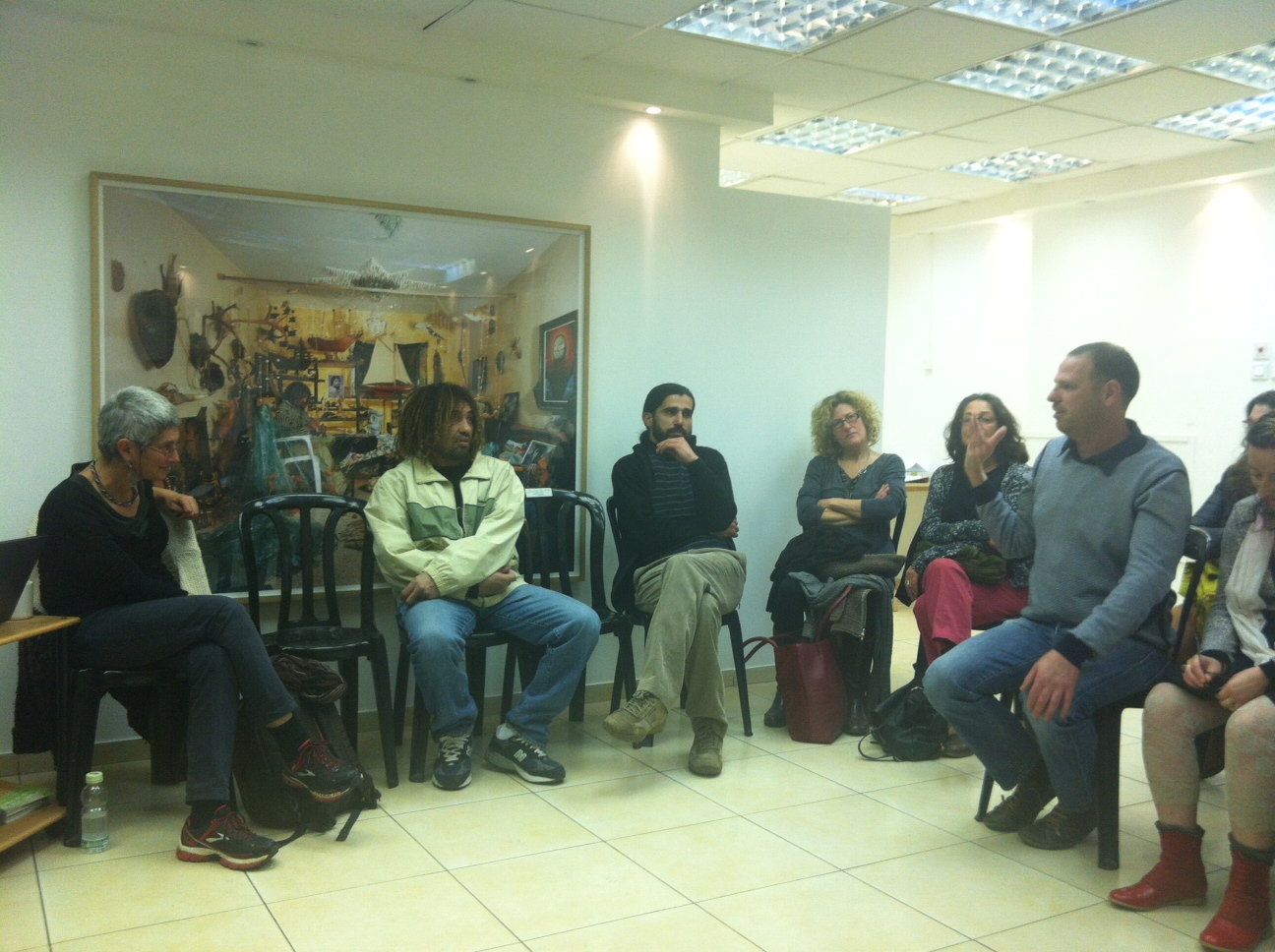
ערב עיון בתערוכה על שפת ים / A discussion at the exhibit On Sea Shore
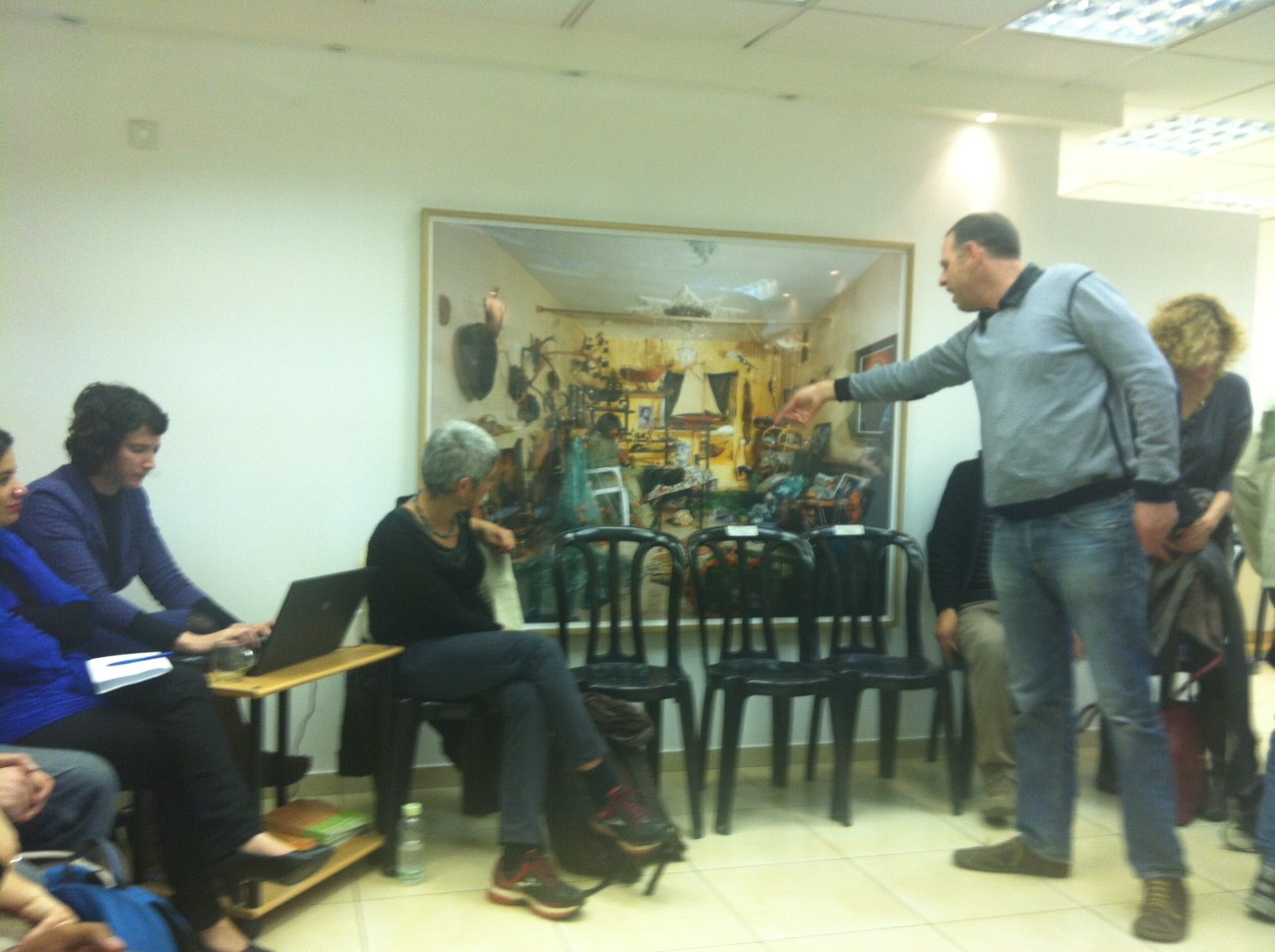
ערב עיון בתערוכה על שפת ים / A discussion at the exhibit On Sea Shore
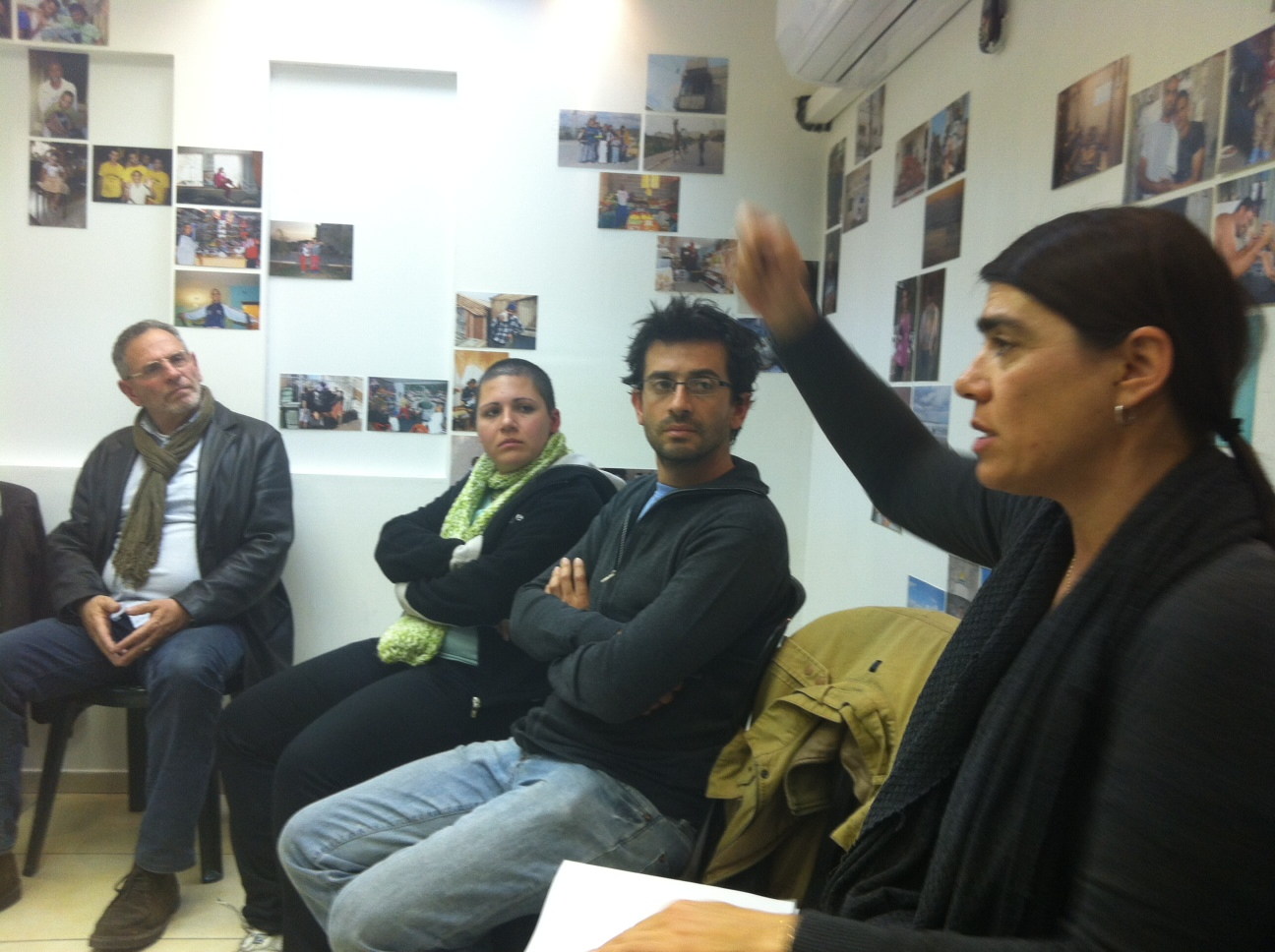
ערב עיון בתערוכה על שפת ים / A discussion at the exhibit On Sea Shore
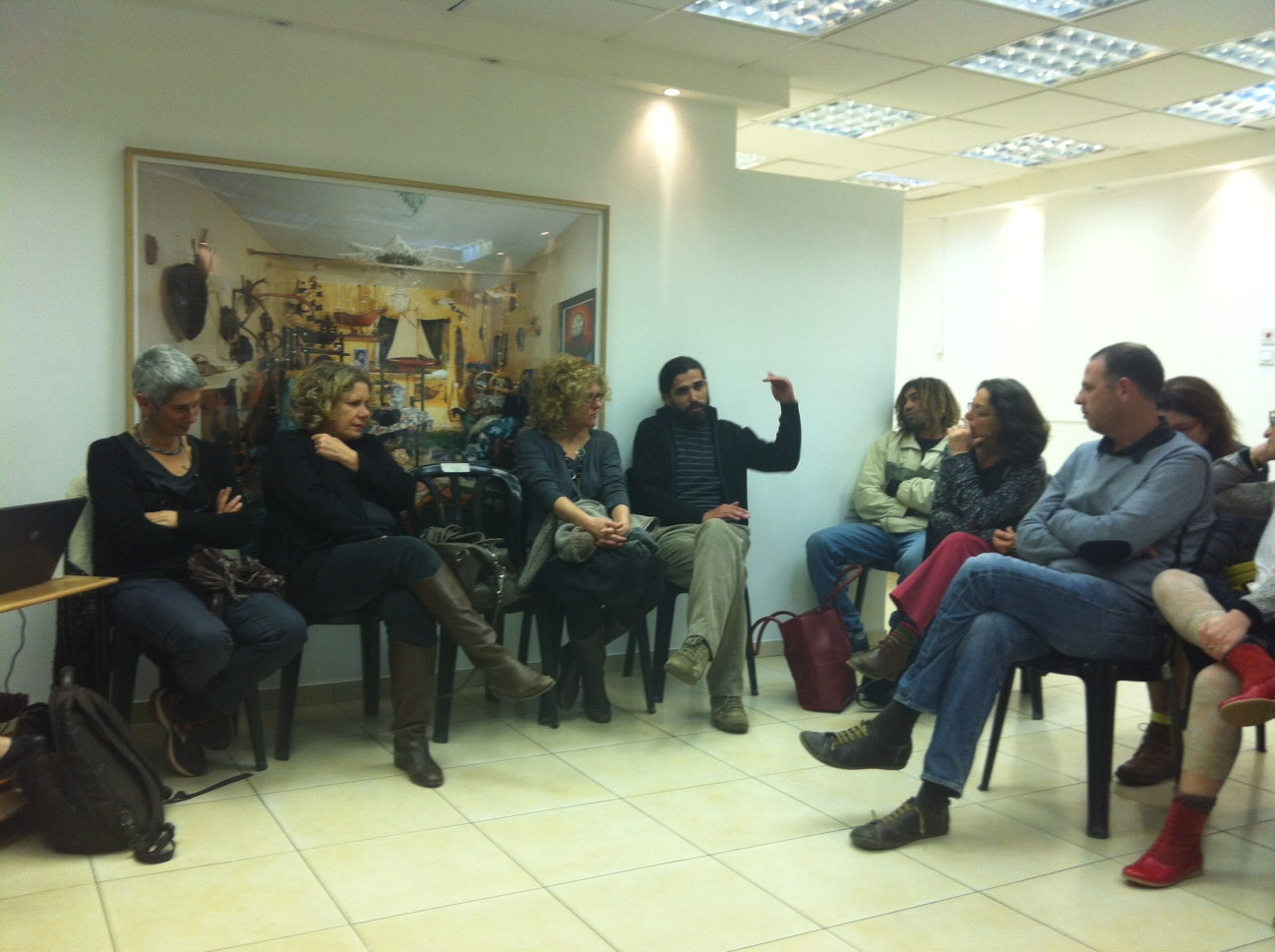
ערב עיון בתערוכה על שפת ים / A discussion at the exhibit On Sea Shore
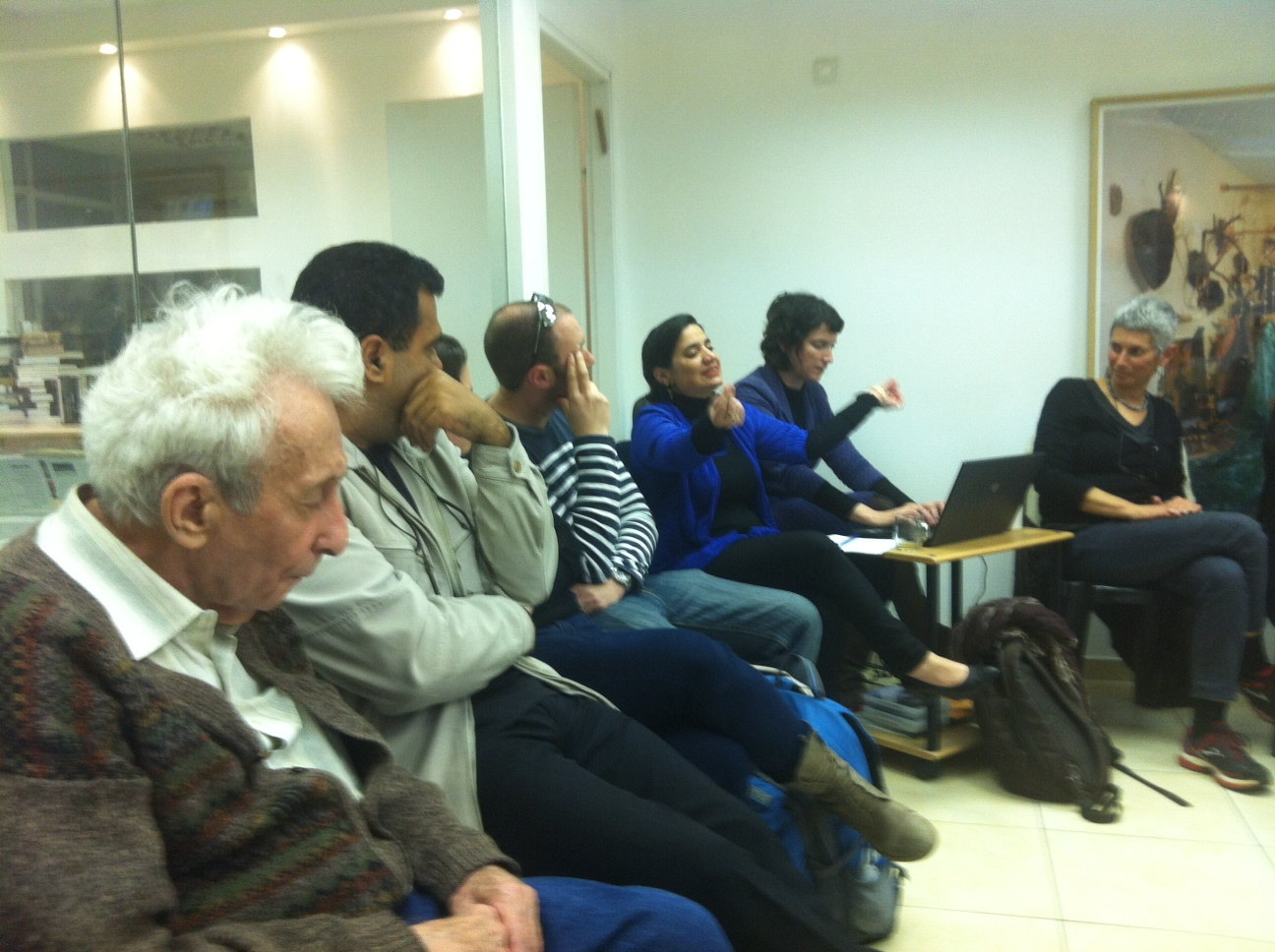
ערב עיון בתערוכה על שפת ים / A discussion at the exhibit On Sea Shore



